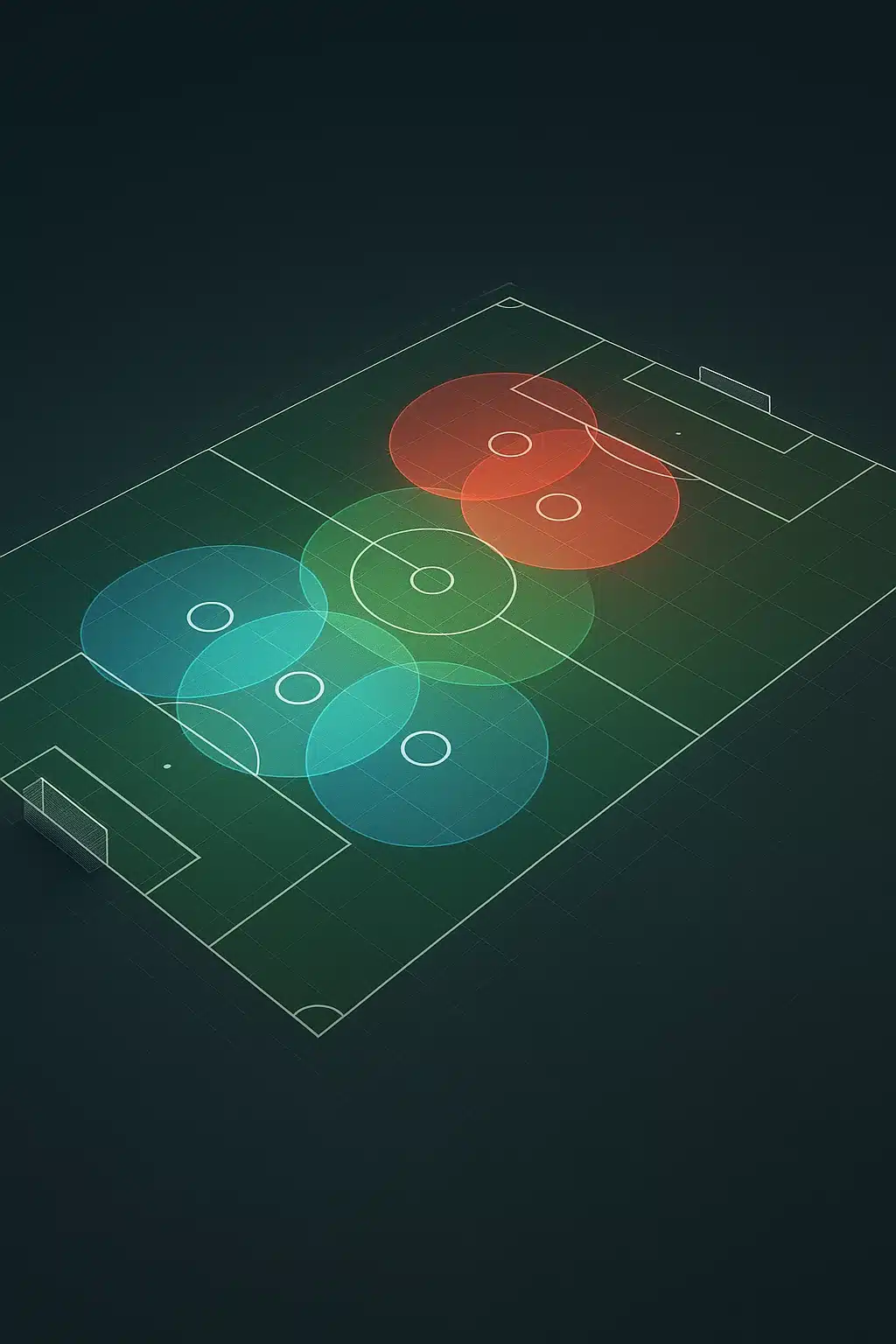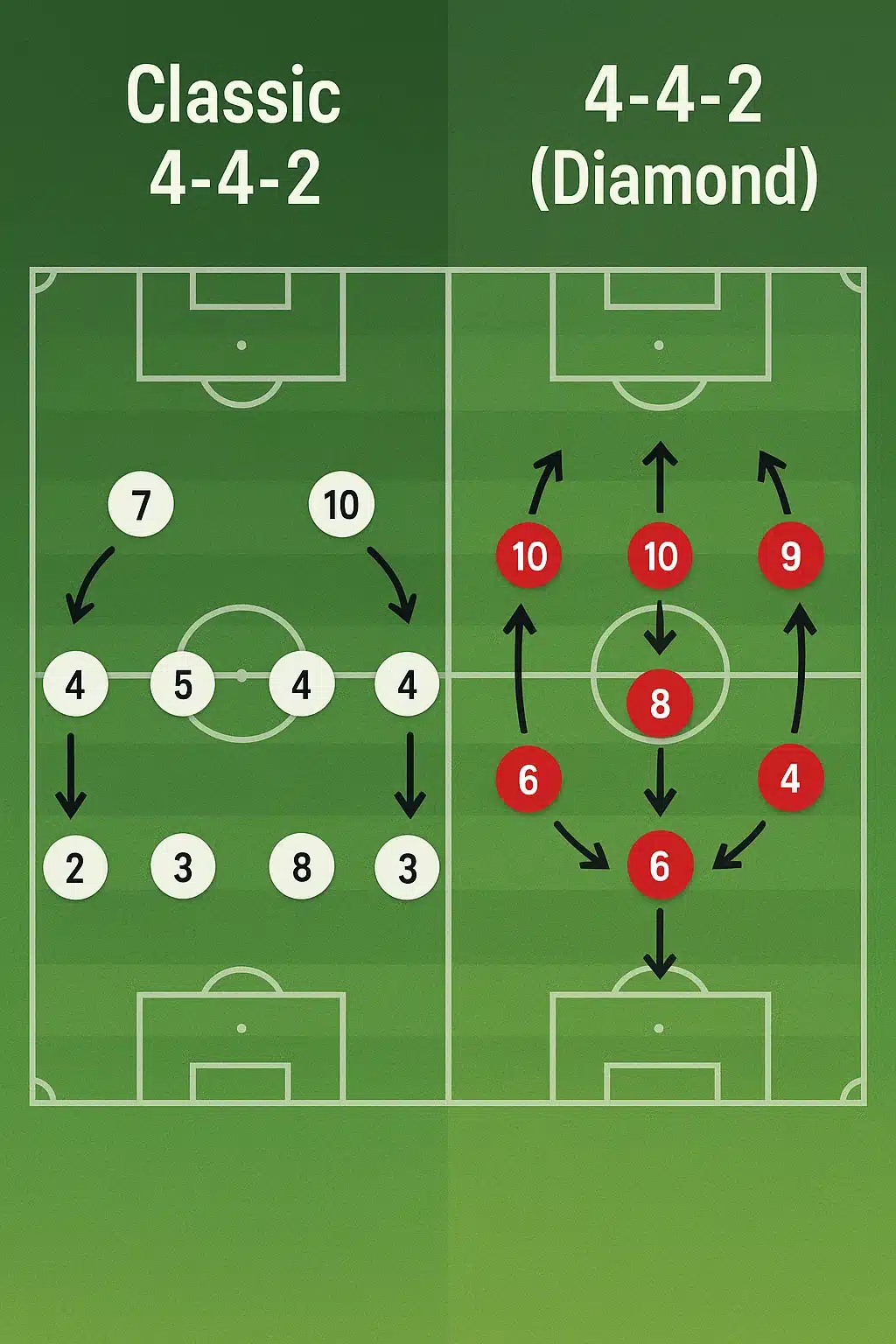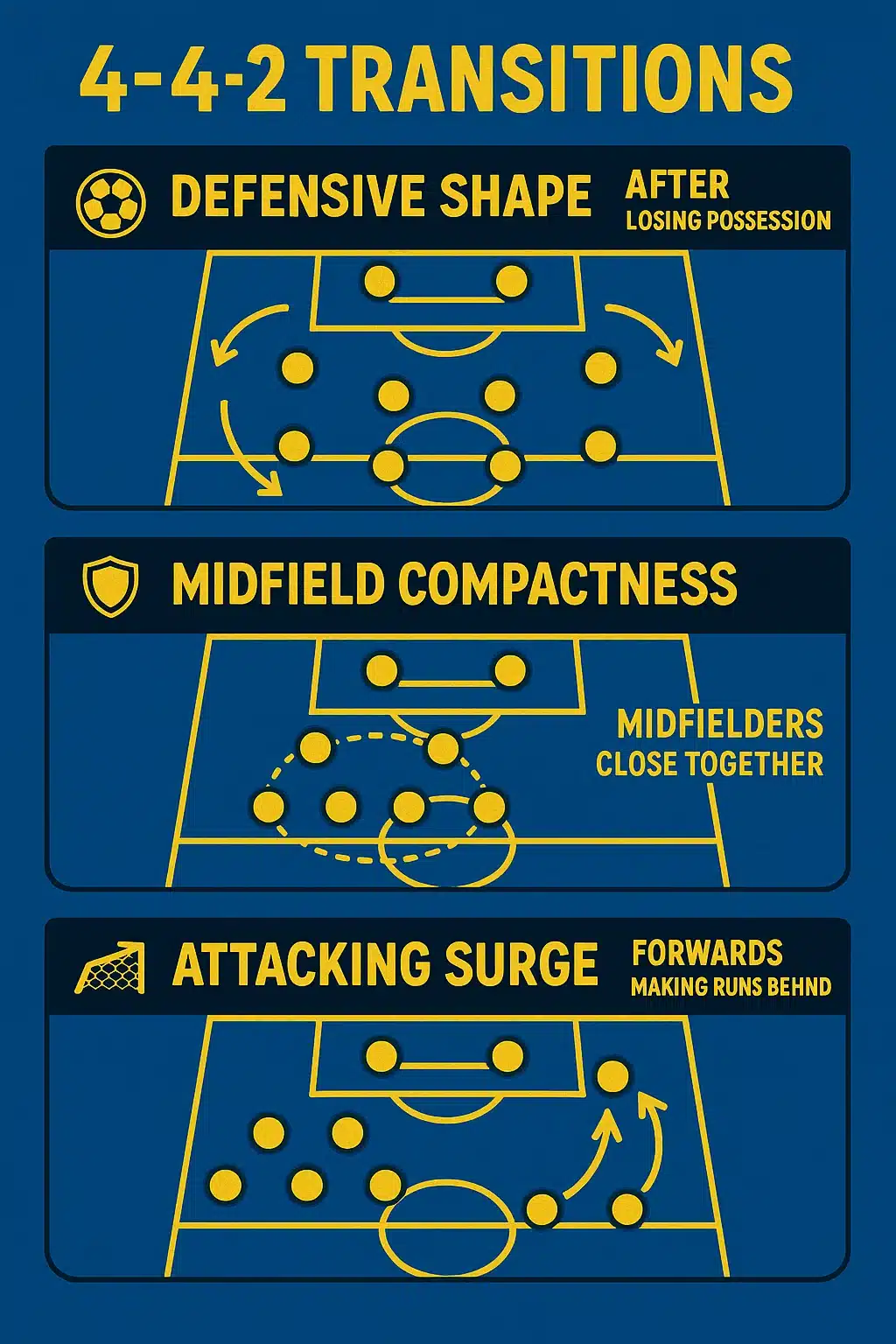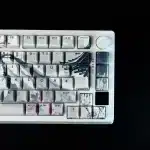Introduction to the Classic 4-4-2 Setup

As a soccer ball lover, you’ve probably noticed how formations shape the flow of a match, and the soccer 4 4 2 formation has been at the heart of soccer tactics for decades. This classic setup, featuring four defenders, four midfielders, and two forwards, offers an excellent balance between defense and attack, making it a favorite for coaches worldwide. What makes this formation timeless and adaptable are its multiple variations that cater to different styles of play and player strengths.
In this article, I’ll guide you through five powerful variations of the soccer 4 4 2 formation that every fan must know. We’ll dive into tactical nuances, player roles, and practical ways these systems have evolved to meet the demands of modern soccer. Whether you’re a weekend warrior, a coach, or an avid supporter looking to deepen your understanding, this breakdown will enrich your appreciation of this classic soccer strategy.
Let’s kick off by exploring the historical roots and core principles of the 4-4-2 formation and then unpack each variation in detail.
Historical Significance and Evolution of 4-4-2 Formation

The soccer 4 4 2 formation traces its prominence back to the 1960s and ’70s when it became the default for many successful teams, especially in England and South America. Its appeal lies in the structural clarity: four defenders forming a solid backline, four midfielders balancing width and centralized control, and two strikers to spearhead attacks.
Historically, this system revolutionized team organization by enforcing balance—ensuring a team wasn’t too vulnerable defensively while maintaining strong offensive options. Icons like Sir Alf Ramsey brought the 4-4-2 to international glory, notably during England’s 1966 World Cup win, proving its effectiveness at the highest level.
Over the years, adaptations have seen the 4-4-2 evolve from a rigid setup to a fluid framework, allowing teams to adjust mid-match depending on opposition styles or player roles. It remains a go-to formation for its simplicity and tactical flexibility.
Core Principles: Balancing Defense and Attack

At its heart, the soccer 4 4 2 formation emphasizes:
- Defensive Solidity: Four defenders provide a strong line, protecting the goal and supporting midfielders during counterattacks.
- Midfield Balance: Four midfielders maintain control both in the center and along the flanks. This ensures supply to the forwards and disrupts opponents’ play.
- Attacking Partnership: Two forwards combine to exploit spaces and pressure opposing defenders, creating opportunities through link-up play or individual brilliance.
This balance allows teams to defend deep or press high, depending on tactical needs, making it incredibly versatile.
Understanding the Flat 4-4-2 Formation: The Foundation

One of the most recognized shapes is the flat 4-4-2, where four midfielders line up evenly across the pitch, creating width and balance.
Roles of Wide Midfielders and Central Midfielders
In this setup, wide midfielders (often wingers or wide central midfielders) are crucial for providing width—driving crosses and stretching the opposition. They are expected to track back, integrating defense with attack, supporting full-backs when outnumbered on the flanks.
Central midfielders typically work as a duo, managing the engine room of the team. One often takes on a more box-to-box role, joining attacks and helping defense, while the other might focus on ball retention and distribution.
Defensive Tactics and Transition Play in Flat 4-4-2
Defensively, flat 4-4-2 forms two midfield lines and a back four, compact but ready to press high in pockets. The backline stays disciplined, often zonal-marking opponents’ attackers. Transition phases are key: quick counterattacks draw on the forwards’ pace, with midfielders pushing up to support.
This formation favors straightforward, disciplined play—ideal for teams adopting quick passing and fast breaks, reminiscent of classic English soccer style.
The Diamond Midfield Variation: Controlling the Center

The diamond (or 4-1-2-1-2) midfield reshapes the flat four by forming a midfield diamond, focusing on central control and ball dominance.
Advantages of Centralized Play in the Diamond Formation
The diamond allows for a clear central attacking midfielder (CAM), the spearhead of creativity linking midfield and attack. This player thrives in tight spaces, delivering key passes or taking shots from distance.
It enhances midfield compactness, allowing intense pressure over the central zones, cutting out opponents’ channels to goal. Defenders enjoy better protection by a defensive midfielder sitting just ahead of them.
Challenges of Flank Coverage and Full-Back Responsibilities
However, this variation sacrifices width in midfield, placing responsibility on full-backs to provide overlapping runs and crossing options. Wide defenders must be tactically disciplined and possess the stamina to shuttle up and down.
Teams running this variation typically have athletic full-backs and midfielders ready to cover when those defenders commit forward.
4-4-2 with Holding Midfielder: Defensive Solidity Meets Offensive Support
Another dynamic variation inserts a holding midfielder into the traditional midfield line (sometimes called a 4-1-3-2), offering a pivot to balance defense and attack.
The Holding Midfielder’s Role in Shielding the Backline
This player’s primary task is to shield the defense by breaking up opposition plays, intercepting passes, and offering passing outlets under pressure. Examples of such players are Claude Makélélé or Sergio Busquets, whose disciplined positioning allowed their teams to maintain defensive shape while launching attacks.
Enabling Creative Freedom for the Attacking Midfielder
With someone keeping watch defensively, the others—particularly an attacking midfielder or wingers—gain freedom to push forward, knowing there’s cover behind them. This variation suits teams aiming for deeper build-up play, slow possession maintenance, but also rapid counter-attacks when the chance arises.
4-4-2 with a Second Striker: Enhancing Offensive Dynamics
Now, this is one of my favorite variations! Incorporating a second striker alongside the main forward (think of classic tandems like Ian Rush and Robbie Fowler) adds an entirely new dimension to attack.
Linking Midfield and Attack: The Number 10 Role
This second striker often drops slightly deeper, acting as a creative link—sometimes dubbed the “Number 10”. Their job is to connect midfield to attack, find pockets between defenders, and create goal-scoring opportunities both for themselves and the main striker.
Risks and Rewards of Deploying a Second Striker
While this boosts attacking options and unpredictability, the biggest risk is weakening midfield numbers. Opponents might exploit this numerically, forcing the wide midfielders or central midfielders to work harder defensively. Teams successfully deploying this variation balance this by pressing aggressively or instructing midfielders to fall back as needed.
Wing-Back Integration in 4-4-2: Overloads on the Flanks
Modern soccer demands width and overloads on the wings, which has influenced some coaches to morph the wide midfielders into wing-backs within the 4-4-2 shell.
Transforming Wide Midfielders into Attacking Wing-Backs
These wing-backs push high, combining defensive duties with offensive thrusts. They become vital in stretching play wide, delivering crosses, and tracking back fast. Players like Dani Alves have epitomized this role, turning defense into attack seamlessly.
Fitness and Positional Discipline Required for Wide Players
This variation demands exceptional fitness and tactical understanding as wide players essentially have dual responsibilities along the entire flank, sometimes running 12-14 kilometers per game. Coaches often highlight the importance of communication to prevent getting caught out on counterattacks.
Alternative Defensive Setup: Sweeper and Stopper Roles in 4-4-2
Though rare nowadays, some 4-4-2 tactics employ classic sweeper and stopper roles in the back four for greater defensive resilience.
How Sweeper and Stopper Enhance Defensive Resilience
The stopper aggressively marks opposition strikers, while the sweeper cleans up behind the defensive line, initiating build-ups from deep. This layered defense can frustrate opponents, particularly in tight games where security is paramount.
Communication and Positional Awareness in Defensive Lines
This setup relies on clear communication and awareness—if either defender loses track, it can lead to defensive breakdown. It suits teams with disciplined defenders who can read the game well, like Franz Beckenbauer’s famous sweeper role in the German national side.
Forward Pairing Strategies: Target Man and Poacher in the 4-4-2 Formation
The forward pair is the heart of the 4-4-2’s attack, and utilizing complementary roles pays dividends.
Exploiting Aerial Ability and Finishing Precision
A classic example is pairing a tall, strong target man capable of holding up the ball and winning aerial duels with a smaller, agile poacher who thrives on quick, clinical finishes. This creates multiple avenues to score—from crosses to flick-ons or rapid counterattacks.
Complementing Each Other: Hold-Up Play and Clinical Scoring
The target man provides link-up play under pressure while the poacher uses intelligence and speed to exploit spaces behind defenses. Successful partnerships such as Alan Shearer and Chris Sutton at Newcastle have shown this synergy’s power.
Advanced Tactical Concepts: False Nine and Deep-Lying Playmaker in a 4-4-2
Though traditionally absent, advanced concepts like the false nine and deep-lying playmaker can be integrated into the 4-4-2 for tactical ingenuity.
Creating Space and Deception with a False Nine
A false nine drops deep from the striker role, pulling defenders out of position and opening channels for midfield runners. This confuses marking schemes and generates numerical superiority in midfield.
Orchestrating Play from Deep: The Deep-Lying Playmaker’s Impact
Similarly, a deep-lying playmaker controls tempo from just in front of defense, distributing passes with precision to launch attacks or maintain possession. Andrea Pirlo’s role in such positions exemplifies why this can be a strategic asset.
Transition Phases: Pressing, Counter-Pressing, and Quick Attacks in 4-4-2
Transition moments—switching from defense to attack or vice versa—are where 4-4-2 excels if well practiced.
Effective Use of Positional Play for Swift Transitions
Teams use compact lines to intercept passes and immediately launch counter-attacks via the wide midfielders or fast forwards. Coordinated pressing traps opponents in their own half, forcing errors.
Training Drills to Enhance Team Cohesion and Tactical Flexibility
Coaches rely on drills emphasizing positional awareness, pressing triggers, and rapid movement off the ball to ingrained these concepts. Small-sided games, rondos, and transition-focused exercises are vital.
Customizing the 4-4-2: Aligning Formation to Player Strengths and Opponent Styles
One of the greatest strengths of the soccer 4 4 2 formation is its adaptability.
Tailoring Variations Based on Squad Attributes
For example, a team rich in athletic wingers might lean on wing-backs and wide midfield dominance, while one with technically gifted midfielders might utilize a diamond shape to control central play.
Adjusting Mid-Game Tactics for Momentum Shifts
Coaches can shift between a flat line and diamond or introduce a second striker as game dynamics evolve, keeping opponents guessing and maximizing player impact.
Conclusion: The Enduring Relevance and Adaptability of the 4-4-2 Formation
For every soccer ball lover, the soccer 4 4 2 formation offers a rich tapestry of tactical flexibility and historical depth. Its variations—from the flat 4-4-2 to the diamond midfield, holding midfielder setups, second striker roles, wing-back integrations, and defensive innovations—demonstrate how this formation adapts to changing demands and player profiles.
Understanding these powerful variations enriches your appreciation of the game’s subtleties and highlights how soccer evolves while staying anchored in timeless principles. The 4-4-2 remains evergreen because it balances the beautiful game’s chaos with structured harmony—something both players and fans can celebrate.
So next time you watch your favorite team or lace up your boots, remember that behind every successful 4-4-2 setup lies these strategic layers, offering countless ways to win on the pitch!
FAQs
1. What makes the soccer 4 4 2 formation so popular among teams?
The 4-4-2 formation balances defense and offense with clear structure, making it easy to organize and versatile for different styles of play, which appeals to many coaches and teams.
2. How does the diamond midfield variation differ from the flat 4-4-2?
The diamond focuses on central control by positioning midfielders in a diamond shape, enhancing central attacking creativity but requires full-backs to cover wide areas, unlike the flat 4-4-2 where midfielders cover the flanks.
3. Why is a holding midfielder important in some 4-4-2 variations?
A holding midfielder protects the defense by breaking up attacks and providing a stable base, allowing attacking midfielders and wingers to push forward with less defensive responsibility.
4. What are the benefits of using a second striker in the 4-4-2 formation?
A second striker adds creativity and goal-scoring options, linking midfield and attack, but it requires midfielders to cover more defensively due to the extra forward deployed.
5. How do wing-backs function in the 4-4-2 formation?
Wing-backs in a 4-4-2 act as both defenders and wide attackers, providing width by overlapping, crossing, and tracking back, demanding high stamina and tactical discipline.
Quick Takeaways/Key Points
- The soccer 4 4 2 formation thrives on balance between defensive stability and attacking options.
- Flat 4-4-2 emphasizes width and defensive shape, ideal for straightforward play.
- Diamond midfield centralizes creativity but relies on full-backs for flank coverage.
- Holding midfielders add protection and tactical flexibility by linking defense and attack.
- A second striker enriches offensive opportunities but requires midfielders to cover defensively.
- Wing-back integration modernizes wide play with more attacking thrust and defensive duties.
- Sweeper-stopper roles enhance backline resilience but need disciplined communication.
- Forward pairings (target man and poacher) exploit complementary strengths for varied attacks.
- False nine and deep-lying playmaker roles add tactical intrigue in the 4-4-2.
- Transition play and pressing drills are key to mastering rapid switches in possession and tactics.
P.S. If you love dissecting soccer tactics and want to master the art of the beautiful game, keep exploring these formations and watch legends bring these variations to life on the pitch!



